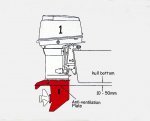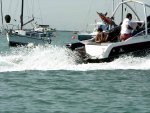Sea Rider
Supreme Mariner
- Joined
- Sep 20, 2008
- Messages
- 12,345
Read repetitive posts of newbie boaters requesting info about which should be the correct OB height when combo undergoes its first dry installation process. The Automatic Rule of Thumb Answer is : Even With Hull (EWH)
To start with this rule aint such, all OBs brands Owners Manuals state different height parameters, which range from 10 to 30 mm for portable to medium HP OBs and from 30 to 50 mm for higher end HP-OBs.

On dry installations this rule of thumb is useless, will not indicate at which lower leg height will water flow pass at speed whatsoever and thats important to know in order for combo to perform top. One story is combo resting on top trailer on land, other much different when combo its on plane gliding on water level. It's about time tu cut this automatic nonsense response given to new boaters forever.
Things you didnt know about that arent mentioned anywhere on this planet but are important to know, mentally dial & understand :
-All boats transom heights are not built exact same. Short ones can range from 38 to 40 cm, Long ones from 50 to 53 cm. Its all down to what the boat manufacturer wants to put on each boat model.
-All OBs brands lower legs are not built with exact same lengths, doesnt matter if comparing S, L, sizes between brands. The given length will depend entirely on each OB manufacturer.
In conclusion : Both OB/Boats manufacturers doesnt care the least which OB & Boat brand you buy. Just sit OB on transom and voil?
As seen, theres a complex OB/transom height divorce unknown for the majority of boaters that will pop up on some of you. So to avoid commercial conflicts, suits among OB/Boats Manufacturers, Dealers & End Boaters, OB manufacturers only state AV Plates/Hull Heights parameters as a precaution and wash hands as Pilatus did.
If you sit any OB brand on any boat brand transom, luckily some combos will achieve opt water performance, but many wont due to lower leg, transom heights stated mismatches. So, some leg brands will work further down, others further up on water when OB its at plane. A combo just sitting on water means nothing, once on plane its everything.
Happy Boating
To start with this rule aint such, all OBs brands Owners Manuals state different height parameters, which range from 10 to 30 mm for portable to medium HP OBs and from 30 to 50 mm for higher end HP-OBs.

On dry installations this rule of thumb is useless, will not indicate at which lower leg height will water flow pass at speed whatsoever and thats important to know in order for combo to perform top. One story is combo resting on top trailer on land, other much different when combo its on plane gliding on water level. It's about time tu cut this automatic nonsense response given to new boaters forever.
Things you didnt know about that arent mentioned anywhere on this planet but are important to know, mentally dial & understand :
-All boats transom heights are not built exact same. Short ones can range from 38 to 40 cm, Long ones from 50 to 53 cm. Its all down to what the boat manufacturer wants to put on each boat model.
-All OBs brands lower legs are not built with exact same lengths, doesnt matter if comparing S, L, sizes between brands. The given length will depend entirely on each OB manufacturer.
In conclusion : Both OB/Boats manufacturers doesnt care the least which OB & Boat brand you buy. Just sit OB on transom and voil?
As seen, theres a complex OB/transom height divorce unknown for the majority of boaters that will pop up on some of you. So to avoid commercial conflicts, suits among OB/Boats Manufacturers, Dealers & End Boaters, OB manufacturers only state AV Plates/Hull Heights parameters as a precaution and wash hands as Pilatus did.
If you sit any OB brand on any boat brand transom, luckily some combos will achieve opt water performance, but many wont due to lower leg, transom heights stated mismatches. So, some leg brands will work further down, others further up on water when OB its at plane. A combo just sitting on water means nothing, once on plane its everything.
Happy Boating
Last edited:






















